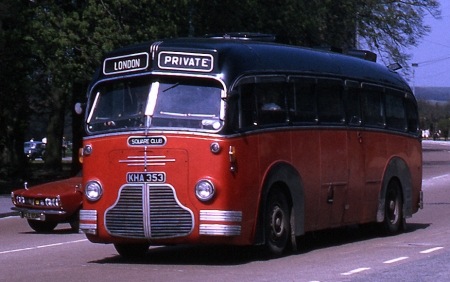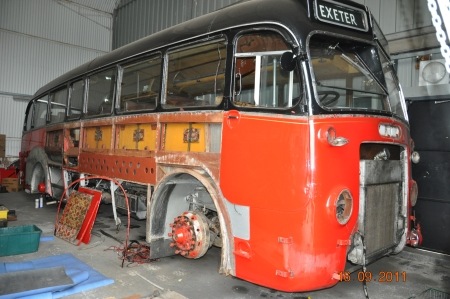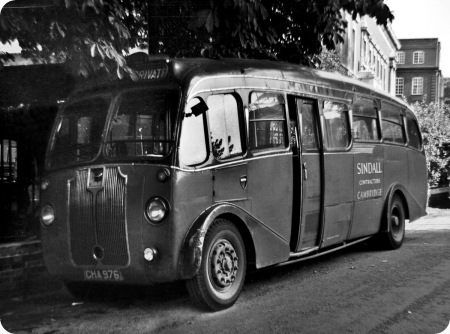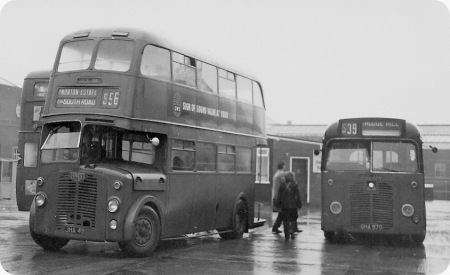Midland Red – BMMO C1 – KHA 301 – 3301
Midland Red (Birmingham and Midland Motor Omnibus Co)
1948
BMMO C1
Duple B40F
This shot was taken in June 2010 at the BaMMOT Museum at Wythall. The beautifully restored example of 45 originally built represents the first post-war coaches introduced by BMMO at their Carlyle works with bodywork by Duple. Based on the service bus (S6) with underfloor engine they were years ahead of their normal control – and half-cab – competitors. Twelve more, designated C2, appeared in 1950– modifications included an outward opening passenger door (replacing sliding) and reduced seating capacity to 26 to cater for the very popular extended tours. These vehicles gave stirling service and, even though larger coaches had been introduced in the mid 50’s, a number were retained for ‘coach cruises’ where narrower and shorter vehicles were required, Devon, Cornwall and the Scottish Highlands, for instance. A number survived well into the mid 1960’s. Even after their revenue earning life a number of these were converted to dual-control and became driver training vehicles into 1970.
Photograph and Copy contributed by Nigel Edwards
19/06/12 – 11:46
Thank you, Nigel, for bringing this beautiful beast to our attention. Another fine example of the industry-leading designs from the Midland Red stable. These C1’s, and the subsequent C2’s with their widely-spaced seating, must have been a delight to ride in. Spurred on by this photo, I have just visited the BaMMOT museum website and note that this coach is not on their rosta. Is it under private ownership?
Paul Haywood
19/06/12 – 13:37
Yes Paul, this vehicle has been in private ownership for many years – the same family I believe – and is, fortunately for us all, a regular rally visitor in many parts of the country. You and other contributors might like to know there is a ‘Midland Red Day’ in October at the BaMMOT, when I am sure this icon will be present. From past experience well worth a visit!
Nigel Edwards
19/06/12 – 16:08
A number of people now have shares in this vehicle. I saw it earlier this year under repair with panels off etc so don’t know when it will be back on the road, but a favourite wherever it goes.
Ken Jones
19/06/12 – 16:09
Thanks, Nigel – I also noticed this event and checked my diary. To my horror, I realised that I had only just booked a 2-day theatre trip for myself, wife and mother-in-law for that very weekend, so it would be suicide if I cancelled – especially for "mere buses"! Ho hum! Next year perhaps?
Paul Haywood
22/06/12 – 15:12
The vehicle repairs are not estimated to be completed before end Dec 2012 and will therefore not be at Wythall on Oct 14.
The Group who own it are about 8 persons strong.
Roger Burdett
23/06/12 – 05:36
What a very pleasant surprise to see a posting from you Roger. I am hoping your beautiful C5 (which I have submitted for a future posting) will be at Wythall when I make my ‘pilgrimage’ from Yorkshire in October – may even be able to take a ‘peek’ inside?. Thanks for the update on 3301.
Nigel Edwards
23/06/12 – 21:29
Nigel mentions the twelve successors to the C1 with Duple C26C bodies for extended tour work. Here is 3353, KHA 353, of the C2 class in May 1970 during the HCVC Brighton Rally. I cannot find any current record of this coach. Does it still exist?
Roger Cox
25/06/12 – 17:12
Nigel
C5 is unlikely to be there either as it is off by rotation ie when you have 18 roadworthy vehicles only a few are on the road at the same time. This was on the road until Sept 2011. If I have few problems then with everything else it might appear.
Roger
Only CL2 that still exists (and not in good condition) is 3352. It was in a garden in Wakefield till 1999 when Alan Bishop paid to bring it South. Work was started but I suspect given the size of the task it has been stopped for a few years now. I do not expect it to be restarted under the current owner
Roger Burdett
08/07/12 – 07:37
I serviced these buses at Newton Means bus depot (Western SMT) Glasgow Scotland in the 60,s & early 70,s on there turn around to London
The innovation of these buses was great the first heavy vehicle I had seen with disc brakes and not drums you couldn’t wait to finish it so you could go for a road test up the Ayr Road, they were great to drive. "OH" how I miss those days when buses were buses and not the junk that they call buses today.
John
09/07/12 – 07:16
3352 stood for years in the drive of a house in Stanley Road Wakefield. It had the name Ronny Storm presumably a kind of pop group.
Philip Carlton
10/07/12 – 06:38
Managed to find picture I took of 3301 under repair as mentioned in recent thread
Ken Jones
10/07/12 – 11:53
A dignified old lady – still looks amazing even when in pieces, long may she live!
Nigel Edwards
21/10/12 – 07:55
3353 was burnt out many years ago, I remember as a small lad I saw it in a yard (farm?) near Cannock with only below window line left. The coach was owned by the 3301 preservation group for spares. It went awol ie pinched by some scrappy about 30 odd years ago.
3352 is in a very bad way, the ribs of the body are all in steel & perished from water ingress so all require replacing, the floor is rotten & half removed. I haven’t worked on it for 10 years & I know nothing will have happened since. Perhaps when it gets passed on it will see the road again. Certainly not with Alan owning it.
Andy Bishop
06/12/12 – 11:56
Kens shot of 3301 under repair (above) took me down memory lane. I did my apprenticeship at Bulwark Workshop In the 1960s. I now live in Melbourne Australia. Keep up the good work.
Mike Jones
06/12/12 – 16:34
Some of us recently had a private visit to Roger Burdett’s place and my article and picture of 3301 as it is now – some 18 months into the restoration – can be seen at www.focustransport.org.uk/
Ken Jones
19/04/14 – 07:33
Many fond memories of this old bus happy hours polishing the grill happy days at rallies across the country my greatest thanks to her old owners Allan, Cliff & Les for letting me ride along so happy to see she is being looked after still may be I get to see her again one day, fond memories.
Christopher Wilkinson
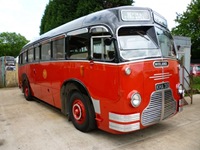 Vehicle reminder shot for this posting
Vehicle reminder shot for this posting
11/05/16 – 06:37
I remember taking my drivers test in this bus in the 1970s I already held a full PSV licence having driven on Walsall transport for a number of years. Even then you had to pass the Midland Red test. When you had passed you felt on top of the world.
Trev Gibbs
Quick links to the - Comments Page - Contact Page - Home Page

